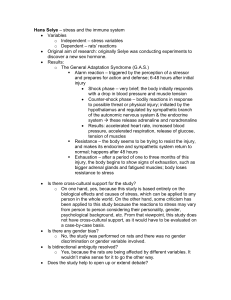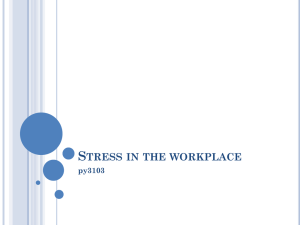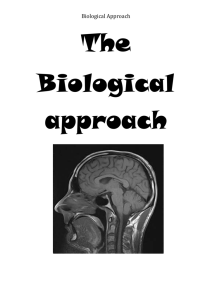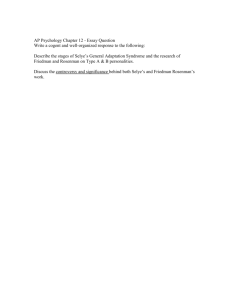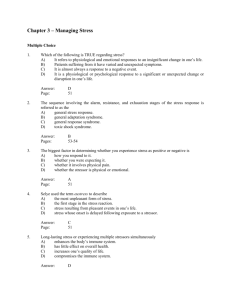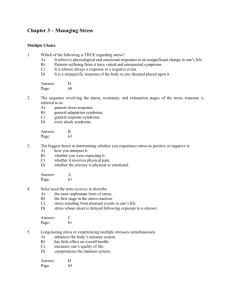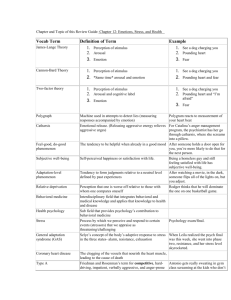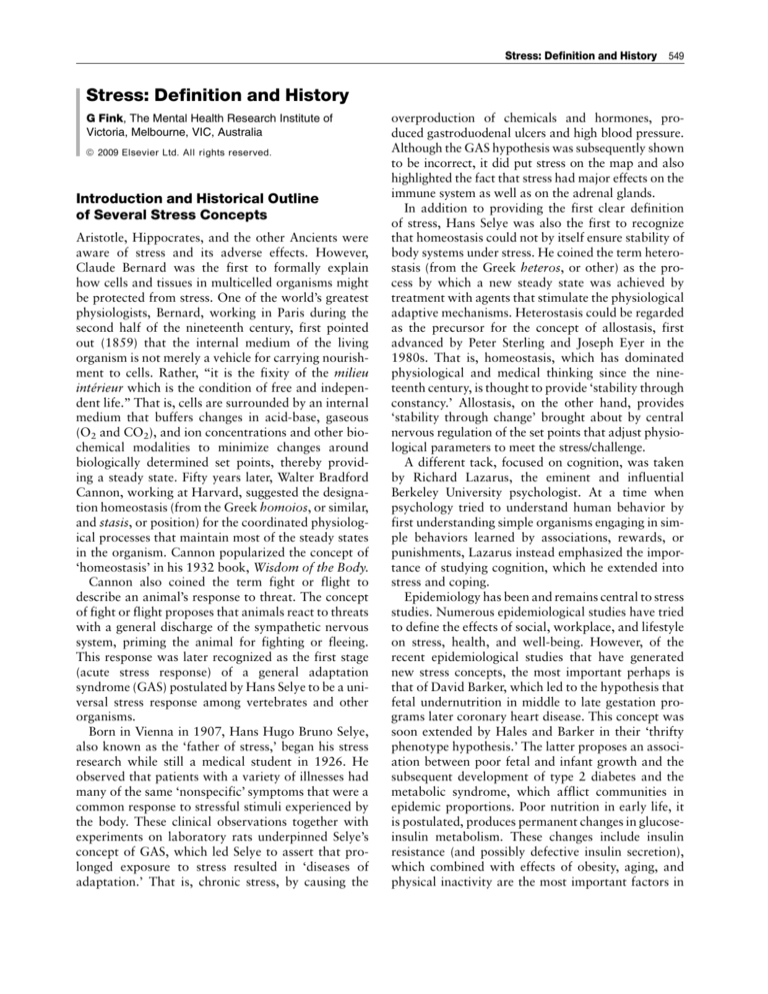
Stress: Definition and History 549
Stress: Definition and History
G Fink, The Mental Health Research Institute of
Victoria, Melbourne, VIC, Australia
ã 2009 Elsevier Ltd. All rights reserved.
Introduction and Historical Outline
of Several Stress Concepts
Aristotle, Hippocrates, and the other Ancients were
aware of stress and its adverse effects. However,
Claude Bernard was the first to formally explain
how cells and tissues in multicelled organisms might
be protected from stress. One of the world’s greatest
physiologists, Bernard, working in Paris during the
second half of the nineteenth century, first pointed
out (1859) that the internal medium of the living
organism is not merely a vehicle for carrying nourishment to cells. Rather, ‘‘it is the fixity of the milieu
intérieur which is the condition of free and independent life.’’ That is, cells are surrounded by an internal
medium that buffers changes in acid-base, gaseous
(O2 and CO2), and ion concentrations and other biochemical modalities to minimize changes around
biologically determined set points, thereby providing a steady state. Fifty years later, Walter Bradford
Cannon, working at Harvard, suggested the designation homeostasis (from the Greek homoios, or similar,
and stasis, or position) for the coordinated physiological processes that maintain most of the steady states
in the organism. Cannon popularized the concept of
‘homeostasis’ in his 1932 book, Wisdom of the Body.
Cannon also coined the term fight or flight to
describe an animal’s response to threat. The concept
of fight or flight proposes that animals react to threats
with a general discharge of the sympathetic nervous
system, priming the animal for fighting or fleeing.
This response was later recognized as the first stage
(acute stress response) of a general adaptation
syndrome (GAS) postulated by Hans Selye to be a universal stress response among vertebrates and other
organisms.
Born in Vienna in 1907, Hans Hugo Bruno Selye,
also known as the ‘father of stress,’ began his stress
research while still a medical student in 1926. He
observed that patients with a variety of illnesses had
many of the same ‘nonspecific’ symptoms that were a
common response to stressful stimuli experienced by
the body. These clinical observations together with
experiments on laboratory rats underpinned Selye’s
concept of GAS, which led Selye to assert that prolonged exposure to stress resulted in ‘diseases of
adaptation.’ That is, chronic stress, by causing the
overproduction of chemicals and hormones, produced gastroduodenal ulcers and high blood pressure.
Although the GAS hypothesis was subsequently shown
to be incorrect, it did put stress on the map and also
highlighted the fact that stress had major effects on the
immune system as well as on the adrenal glands.
In addition to providing the first clear definition
of stress, Hans Selye was also the first to recognize
that homeostasis could not by itself ensure stability of
body systems under stress. He coined the term heterostasis (from the Greek heteros, or other) as the process by which a new steady state was achieved by
treatment with agents that stimulate the physiological
adaptive mechanisms. Heterostasis could be regarded
as the precursor for the concept of allostasis, first
advanced by Peter Sterling and Joseph Eyer in the
1980s. That is, homeostasis, which has dominated
physiological and medical thinking since the nineteenth century, is thought to provide ‘stability through
constancy.’ Allostasis, on the other hand, provides
‘stability through change’ brought about by central
nervous regulation of the set points that adjust physiological parameters to meet the stress/challenge.
A different tack, focused on cognition, was taken
by Richard Lazarus, the eminent and influential
Berkeley University psychologist. At a time when
psychology tried to understand human behavior by
first understanding simple organisms engaging in simple behaviors learned by associations, rewards, or
punishments, Lazarus instead emphasized the importance of studying cognition, which he extended into
stress and coping.
Epidemiology has been and remains central to stress
studies. Numerous epidemiological studies have tried
to define the effects of social, workplace, and lifestyle
on stress, health, and well-being. However, of the
recent epidemiological studies that have generated
new stress concepts, the most important perhaps is
that of David Barker, which led to the hypothesis that
fetal undernutrition in middle to late gestation programs later coronary heart disease. This concept was
soon extended by Hales and Barker in their ‘thrifty
phenotype hypothesis.’ The latter proposes an association between poor fetal and infant growth and the
subsequent development of type 2 diabetes and the
metabolic syndrome, which afflict communities in
epidemic proportions. Poor nutrition in early life, it
is postulated, produces permanent changes in glucoseinsulin metabolism. These changes include insulin
resistance (and possibly defective insulin secretion),
which combined with effects of obesity, aging, and
physical inactivity are the most important factors in
550 Stress: Definition and History
determining type 2 diabetes. Many studies worldwide
have confirmed Barker’s initial epidemiological evidence, although the strength of the relationships has
varied between studies.
With advances in genomics, the concept of susceptibility genes that increase the vulnerability of individuals to stressful life events has attracted considerable
research interest. Thus, for example, the work of
Avshalom Caspi and associates suggests that a polymorphism in the monoamine oxidase A (MAOA) gene
promoter, which reduces MAOA expression, influences vulnerability to environmental stress, and that
this biological process can be initiated by childhood
abuse. Furthermore, Caspi and associates, working
at the Institute of Psychiatry, London, have demonstrated that a polymorphism in the promoter of the
serotonin transporter gene can render individuals
more susceptible to stressful life events. In addition
to their disorder-specific value, these findings have
heuristic value for further thinking and research on
genetic–environmental interactions that determine
the response to stress and the development of mental
disorders.
In parallel with these stress concepts, neuroendocrine advances revealed the physiological substrate for homeostasis, allostasis, and the stress
response mechanisms. The autonomic nervous and
the hypothalamic–pituitary–adrenocortical (HPA)
systems subserve the afferent and efferent limbs of
the stress response in vertebrates and are also central
to maintaining homeostasis and effecting allostasis.
The term autonomic nervous system was coined in
1898 by the Cambridge physiologist John Newport
Langley, who was also renowned for his development
(in parallel with Paul Ehrlich) of receptor theory. Controlled by the brain, and utilizing as neurotransmitters
epinephrine and norepinephrine (sympathetic nervous component) or acetylcholine (parasympathetic
component), the role of the autonomic nervous system
in fight-or-flight and homeostasis (especially cardiovascular) was clearly explained by Walter Cannon.
The story of our understanding of the HPA, and the
concept of the neurohumoral hypothesis of anterior
pituitary control, is tortuous. The pituitary gland had
long been regarded, by luminaries such as the great
Harvard neurosurgeon Harvey Cushing, as the autonomous controller of the adrenal cortex, the thyroid,
and the gonads. That is, the anterior pituitary gland
was considered to be the ‘conductor of the endocrine
orchestra.’ This view was reinforced by the dramatic
effects of experimental pituitary removal (hypophysectomy) in rodents made feasible by the parapharyngeal surgical approach to the pituitary developed
by PE Smith in approximately 1930. However, at
approximately the same time, experiments were in
progress that would eventually prove that the anterior pituitary gland is not autonomous; rather, it is
controlled by the brain. The first of these experiments, carried out by William Rowan working alone
at 50 C in Edmonton, Alberta, in the late 1920s,
showed that migration in birds was controlled by the
gonads, and that gonadal size in birds was increased
many-fold by increases in day length. Day length and
the effects of other exteroreceptive factors, such as
stress, on endocrine function together with the effects
of brain tumors and trauma in the human led to an
acceptance of the then (1930s) revolutionary concept
that the pituitary gland is under central nervous system (CNS) control.
The neural lobe of the pituitary gland is composed
of nerve projections from the paraventricular and
supraoptic nuclei of the hypothalamus: these projections terminate on systemic blood vessels into which
they release the nanopeptide neurohormones, vasopressin and oxytocin. In contrast, the anterior pituitary gland receives no direct innervation from the
brain. Rather, the CNS control of the anterior pituitary gland is mediated by neurohormones synthesized
and released from hypothalamic neurons and transported to the anterior pituitary gland by the hypophysial portal vessels. Proof of the neurohumoral
hypothesis of anterior pituitary control came, first,
from the elegant pituitary stalk section and pituitary
grafting experiments of Geoffrey Harris and Dora
Jacobsohn; second, from the characterization of some
of the neurohormones by Andrew Schally and Roger
Guillemin, for which they were awarded the 1977
Nobel Prize for physiology and medicine; and third,
from the demonstration, first by my group, that these
neurohormones were indeed released into hypophysial portal blood. Corticotropin-releasing factor
(CRF), a 41-amino-acid peptide that mediates neural
control of adrenocorticotropic hormone (ACTH)
release from pituitary corticotropes, was isolated and
sequenced by Wylie Vale and associates in 1981.
A series of physiological studies, including measurements of neurohormone release into hypophysial portal blood in vivo, have confirmed earlier views that
arginine vasopressin acts synergistically with CRF to
control ACTH release.
Finally, no outline of the history of stress concepts
would be complete without mention of the characterization of the adrenocortical glucocorticoids and their
function. The glucocorticoids are steroid hormones
whose secretion by the adrenal cortex is controlled by
ACTH. The hormones of the adrenal cortex were
isolated, identified, and synthesized independently
by Edward Kendall (at the Mayo Foundation) and
Tadeus Reichstein (at Zurich) and their associates.
The availability of large amounts of synthetic steroids
Stress: Definition and History 551
enabled their physiological effects to be studied. Ultimately, Philip Hench was able to test the glucocorticoid, cortisone, in the human and demonstrate that it
is a powerful anti-inflammatory agent. Hench, at the
Mayo Foundation, had previously observed that rheumatoid arthritis was sometimes relieved during pregnancy and in some patients with jaundice, leading
him to conclude that the pain-alleviating substance
was a steroid. Kendall, Hench, and Reichstein were
jointly awarded the Nobel Prize for physiology and
medicine for 1950, and synthetic glucocorticoids
continue to be used to treat arthritis, asthma, autoimmune conditions, and other inflammatory disorders in humans.
Definitions of Stress
Stress has a different meaning for different people
under different conditions. The first and most generic
definition of stress is that proposed by Hans Selye:
‘‘Stress is the nonspecific response of the body to any
demand.’’ Selye repeatedly emphasized the fact that
the continued use of the word stress as a nonspecificresponse to any demand was most appropriate. Selye
argued that stress is not identical to emotional arousal
or nervous tension since stress can occur under or in
response to anesthesia in man and animals, and it can
also occur in plants and bacteria that have no nervous
system. This point is elaborated later in the context
of stress-induced heat shock proteins (Hsps) that play
a key role in cytoprotection across all three phylogenetic domains of organisms on Earth. The word
stress, as used by Selye, is accepted in all foreign languages, including those in which no such word
existed previously.
Stress, Selye underscored,
is not something to be avoided. Indeed, it cannot be
avoided, since just staying alive creates some demand
for life-maintaining energy. Even when man is asleep,
his heart, respiratory apparatus, digestive tract, nervous
system, and other organs must continue to function.
Complete freedom from stress can be expected only
after death.
There has been much controversy and debate about
Selye’s concepts and particularly Selye’s view that
stress is best regarded as a nonspecific response.
Because of their heuristic value, these points will be
further considered later.
Other definitions, reviewed in detail by Selye in his
treatise Stress in Health and Disease, include the
following:
1. In behavioral sciences, stress is regarded as the
‘‘perception of threat, with resulting anxiety discomfort, emotional tension, and difficulty in adjustment.’’
2. In the group situation, lack of structure or loss
of anchor ‘‘makes it difficult or impossible for the
group to cope with the requirements of the situation,
and the problem of leadership and interpersonal
behavior becomes one of evolving or supplying a
structure or anchor and of supplying the expertness
for coping with the demands of the situation.’’
3. Stress can also be defined in terms of pure
neuroendocrinology. Eugene Yates, for example,
defined stress as any stimulus that will provoke the
release of ACTH and adrenal glucocorticoids. Presumably, the same might apply to the equally powerful sympathetic markers of stress, underscored earlier
by Walter Cannon.
4. Finally, Selye also mentions Richard Lazarus,
famous for his work in cognitive psychology and
focus on the emotions. Lazarus underscores the difficulties of reaching a precise overarching definition of
stress by setting out the following different meanings
of the term: ‘‘In spite of consistent confusion about
the precise meaning of the term, stress is widely recognized as a central problem in human life. Scientists
of many disciplines have conceptualized stress but each
field appears to have something different in mind
concerning its meaning. For the sociologist, it is social
disequilibrium, that is, disturbances in the social structure within which people live. Engineers conceive of
stress as some external force which produces strain in
the materials exposed to it. Physiologists deal with the
physical stressors that include a wide range of stimulus
conditions that are noxious to the body. In the history
of psychological stress research, there has been no clear
separation between physical stressors which attack
biological tissue systems and psychological stressors
which produce their effects purely because of their
psychological significance.’’
Selye’s Definition of Stress – A Further
Consideration
Selye’s definition and concept of stress has remained
controversial. For some, his definition is too biological
and ignores cognitive and psychological factors, a criticism that seems to stem from the mistaken idea that
cognition is not a function of the brain (a reversion to
Rene Descartes’ outmoded doctrine that mind and body
are separate). For others, Selye’s definition is too general. This section reviews the basis for Selye’s definition
of stress and considers whether the criticisms leveled at
Selye’s stress concept are valid. Overall, our observations suggest that Selye fully understood so-called
psychological or cognitive stress, and that the generality
of Selye’s stress definition has facilitated the molecular,
genotypic and phenotypic analysis of stress and stress
responses across all species from bacteria to man.
552 Stress: Definition and History
General Adaptation Syndrome
Selye first put stress on the map with GAS. In search
of a new hormone, Selye injected extracts of cattle
ovaries into rats. The injection caused the following
characteristic triad:
1. The adrenal cortex became enlarged and discharged lipid secretory granules.
2. The thymus, spleen, lymph nodes, and all other
lymphatic structures showed severe involution.
3. Deep bleeding ulcers appeared in the stomach and
duodenum.
Selye at first thought that these effects were due to a
new hormone in the extracts but soon found that all
toxic substances – extracts of kidneys, spleen, and
even toxicant not derived from living tissue produced
the same syndrome.
Selye surmised that the response to the injection of
toxic substance reflected his ‘‘classroom concept’’ of
‘‘the syndrome of just being sick.’’ That is, adrenal
enlargement, thymicolymphatic involution, and gastrointestinal ulcers were the omnipresent signs of damage
to the body when under attack. The three changes thus
became (for Selye) the objective indices of stress and the
basis for the development of the entire stress concept.
First described in a note to Nature in 1936, GAS
has three stages: alarm, resistance, and exhaustion.
In the alarm stage, the body shows changes characteristic of the first exposure to the stressor; these
changes generally coincide with the sympathetic discharge that enables the fight-or-flight phenomenon of
Cannon. If the stressor continues and is compatible
with adaptation, features of the alarm reaction disappear and resistance develops. Prolonged exposure
to the stressor may result in exhaustion and finally
death.
One of the most important findings of GAS is the
stress-induced thymicolymphatic involution, which
highlighted for the first time that stress has a major
impact on the immune system. This concept preceded
by more than 20 years the discoveries of lymphocyte
recirculation by James Gowans and acquired immunological tolerance by MacFarlane Burnet and Peter
Medawar. Selye’s discovery began the field of neuroimmunomodulation.
Selye soon became aware of the fact that the adrenal
enlargement of GAS was associated with increased
secretion of glucocorticoids (cortisol or corticosterone) that
induce glycogenolysis, thereby supplying a readily available source of energy for the adaptive reactions necessary
to meet the demands made by the stressors. In addition,
they facilitate various other enzymatically regulated
adaptive metabolic responses and suppress immune
reactions as well as inflammation, assisting the body to
coexist with potential pathogens.
Selye asserted that glucocorticoids are needed for
adaptation to stress primarily during the alarm reaction. Selye’s view that glucocorticoids enhance and
mediate the stress response has been upheld with the
additional concepts that glucocorticoids play a permissive role that primes the body’s stress response
systems and also prevent overshoot of the defense
systems. Overshoots in the body’s defense system are
perhaps most dramatically seen in major inflammatory cataclysms called cytokine storms and the consequent systemic inflammatory response syndromes
that play a key role in the lethality of avian influenza
and have also occurred in response to the injection of
certain antibodies. Exogenous synthetic glucocorticoids such as methylprednisolone remain a mainstay
of the treatment of cytokine storms.
Although GAS is sometimes manifest in extreme
stress, the three components of GAS have not withstood the test of time as indices of stress as Selye had
originally proposed. Rather, the main biological markers of stress have long been behavioral observations
and tests and measures of sympathetic and HPA activation. In the case of the latter measurements of
glucocorticoid concentrations in blood, either alone
or in parallel with plasma concentrations of ACTH,
have been used as the main biological indices of
stress. So, despite its heuristic value, especially for
stress-induced neuroimmunomodulation, the concept
of GAS has lost scientific currency.
Stressors: Features of and Lack of Stressor Sign
In Stress in Health and Disease, Selye underscored the
fact that
stress is part of our daily human experience, but it is
associated with a great variety of essentially dissimilar
problems, such as surgical trauma, burns, emotional
arousal, mental or physical effort, fatigue, pain, fear,
the need for concentration, the humiliation of frustration, the loss of blood, intoxication with drugs or environmental pollutants, or even the kind of unexpected
success that requires an individual to reformulate his
lifestyle. Stress is present in the businessman under constant pressure; in the athlete straining to win a race; in
the air-traffic controller who bears continuous responsibility for hundreds of lives; in the husband helplessly
watching his wife’s slow, painful death from cancer;
in a race horse, its jockey, and the spectator who bets
on them.
Selye went on to argue that ‘‘while all these subjects
face quite different problems they respond with a
stereotyped pattern of biochemical, functional, and
structural changes essentially involved in coping with
Stress: Definition and History 553
any type of increased demand upon vital activity,
particularly adaptation to new situations.’’
Selye also asserted that stressors have no sign as far
as evoking the stress response. That is, the response
will be the same ‘‘whether the agent or situation being
faced is pleasant or unpleasant; all that counts is the
intensity of the demand for readjustment or adaptation that it creates.’’ Selye underscored this point with
the following poignant example:
Criticism of Selye’s definition of stress has been put
to experimental test. Pacak, Palkovits, and associates,
for example, demonstrated that different stressors
activate different stress biomarkers and different
regions of the brain. Thus, low blood glucose concentrations (glucopenia) or hemorrhage activate both
sympathetic and HPA systems; hyperthermia, cold,
and formalin injection selectively activate the sympathetic system. On the basis of these data, Pacak and
Palkovits conclude that each stressor has its own specific neurochemical signature. However, since these
stress indices are limited to just two neurohumoral
systems, and since for most stressors there is at least
some overlap in response, it is not clear that this
approach invalidates Selye’s definition, ‘‘stress is the
nonspecific response of the body to any demand,’’
which would probably be unassailable had Selye
omitted the term ‘nonspecific.’
classified into three main evolutionary lines or phylogenetic domains: Bacteria (eubacteria), Archaea
(formerly archaebacteria), and Eucarya (eukaryotes,
which encompass all plants and animals through
to man). The cellular response to stress in all three
phylogenetic domains is represented at the molecular level by the stress-induced synthesis of stress or
Hsps, of which molecular chaperones and proteases
represent two well-characterized families. The heat
shock response was discovered in 1962 by Ritossa,
who observed a pattern of Drosophila salivary gland
chromosome puffs that were induced in response to
transient exposure to elevated temperatures. Since
then, many studies have shown that the heat shock
response is ubiquitous and highly conserved in all
organisms from bacteria to plants and animals. It
is an essential defense mechanism for protection of
cells from a wide range of stressors, including heat
shock, alcohols, ischemia, inhibitors of energy metabolism, heavy metals, oxidative stress, fever, or inflammation, which depending on amplitude and duration
can all cause cell death by apoptosis or necrosis. The
heat shock response can protect against stress-induced
cell death by way of a cell-protective process known
as thermotolerance or cytoprotection, in which exposure of cells to mild stress conditions, sufficient to
induce the expression and accumulation of Hsps, protects against a subsequent challenge from another
stress that is, by itself, lethal. Although their precise
function remains to be determined, the high degree of
conservation of these Hsps across species, coupled
with their importance in cell survival in various conditions, suggests that Hsps are critical for both normal
cellular function and survival after a stress. Several
cytoprotective functions have been attributed to
Hsps and, in particular, the HSP70 family. These
include (1) the folding of proteins in various intracellular compartments, (2) the maintenance of structural proteins, (3) the refolding of misfolded proteins,
(4) translocation of proteins across membranes and
into various cellular compartments, (5) the prevention
of protein aggregation, and (6) the degradation of
unstable proteins. Hsps also serve as modulating signals for immune and inflammatory responses, and
they may have a role in cytokine production.
So, for the heat shock response to stressful stimuli,
Selye’s ‘‘stress is the nonspecific response of the
body [or cell] to any demand’’ would appear to be
appropriate.
Heat Shock (Stress) Proteins
Concepts of Stress and Disease
Whatever the shortcomings of Selye’s definition of
stress for the human, it is probably appropriate for
the vast majority of living organisms. Living cells are
There is a vast literature on the role or possible role of
stress in the causation and/or exacerbation of disease
in most organ systems of the body. Here, attention
The mother who is suddenly told that her only son died in
battle suffers a terrible mental shock; if years later, it turns
out that the news was false and the son unexpectedly
walks into her room alive and well, she experiences
extreme joy. The specific results of the two events, sorrow
and joy, are completely different, in fact they are opposite
to each other, yet their stressor effect – the nonspecific
demand for readjustment to a new situation – is the same.
Nonspecificity of Stress Response
Selye seemed to have been driven to find specificity in
the response to different types of stressors. Thus,
again in Stress in Health and Disease he wrote,
It is difficult to see at first how such essentially different
things as cold, heat, drugs, hormones, sorrow, and joy
could provoke an identical biologic reaction. Nevertheless this is the case; it can now be demonstrated by highly
objective, quantitative biochemical and morphologic
parameters that certain reactions are totally nonspecific
and common to all types of agents, whatever their superimposed specific effects may be.
554 Stress: Definition and History
is focused on mental disorders. The Diagnostic and
Statistical Manual of Mental Disorders (DSM-IV) of
the American Psychiatric Association recognizes two
stress disorders: acute stress disorder and posttraumatic stress disorder (PTSD). For the diagnosis of
acute stress disorder, the individual, while experiencing the trauma or after the event, must have at least
three of several dissociative symptoms, such as a subjective sense of numbing, detachment, or absence of
emotional responsiveness; reduction in awareness of
surroundings; depersonalization; or dissociativeamnesia. Following the trauma, the traumatic event
is persistently reexperienced, the individual avoids
stimuli that may arouse recollections of the traumatic
event, and he or she has anxiety or increased arousal.
The trauma causes clinically significant distress or
impairment in social, occupational, or other important areas of functioning.
PTSD is defined as a condition in which a traumatic
event is persistently reexperienced in the form of
intrusive recollections, dreams, or dissociative flashback episodes. Cues to the event lead to distress and
are avoided, and there are symptoms of increased
arousal. To meet the diagnostic criteria of the DSMIV, the full symptom picture must be present for more
than 1 month, and the disturbance must cause clinically significant distress or impairment in social,
occupational, or other areas of functioning.
PTSD has only been accepted officially as a mental
disorder since 1980, when it was included, amid considerable controversy, in the DSM-III. References to
the aftereffects of psychological trauma date back as
far as the third century BC; achieved prominence
during the early period of the railroad in Britain
when rail travel, then precarious and physically traumatic, gave rise to a syndrome called railway spine or
postconcussion syndrome; and were regarded as the
basis for hysteria at the turn of the nineteenth century
by neurologists and psychiatrists such as Jean-Martin
Charcot, Pierre Janet, and Sigmund Freud. Long
before PTSD was included in any diagnostic system,
Charles Dickens wrote A Tale of Two Cities (1859),
which can be considered as an early case report of
PTSD. Interest in PTSD increased dramatically during World War I: Charles Samuel Myers was the first
to coin the term and report case histories of ‘shell
shock,’ which described a condition that afflicted
many troops who screamed and wept uncontrollably,
froze and could not move, became mute and
unresponsive, and lost their memory, sensations,
and capacity to feel. Pat Barker’s monumental trilogy,
Regeneration, deals poignantly with the psychological traumas of war and the nature of shell shock.
The condition occurred again in vast numbers of
people as a consequence of World War II. However,
it was the psychological trauma experienced by Vietnam veterans and their demand for compensation
that led to the inclusion of PTSD in the DSM-III as a
condition that occurred both in civilian (e.g., rape
trauma syndrome, battered woman syndrome, and
abused child syndrome) and in military trauma response syndromes.
Future Developments of Stress Concepts
This brief account of some of the definitions and
concepts of stress shows that there is still much to
be done in the area of stress research. Thus, with
respect to gene–environmental interactions, work on
susceptibility genes has just begun, and there is still
much room for expanding our knowledge about the
role in stress of epigenetic factors and other mechanisms of gene control such as RNA interference. On
the basis of previous experience, it seems likely that
Barker’s ‘fetal origins’ hypothesis might be honed and
revised and may lead to a robust understanding of the
metabolic syndrome and diabetes type 2. New powerful computer analysis of brain imaging and electrical
recording may help to resolve the many questions that
surround consciousness and cognition. The vexed
cause-and-effect questions regarding the influence of
stress in mental disorders, cancer, and other diseases
need to be answered. In the past 25 years, we have
witnessed how Selye’s cherished and widely accepted
axiom that stress is the cause of gastric ulceration (one
of the three components of GAS) was undone by the
careful observations and courageous perseverance
of Barry Marshall and Robin Warren, who demonstrated that, in fact, most gastroduodenal ulcers are
caused by a microbe, Helicobacter pyloris, that is
readily amenable to treatment with antibiotics. And
yet, there is evidence that stress does play a role in
gastric ulceration, so the stress – H. pyloris interaction
needs to be worked out. These and other biological
questions about stress are likely to be tractable –
rational and rigorous biology will almost certainly
win the day.
However, the causes of human stress, acute and
posttraumatic, are commonly social and sociological,
political and irrational (beliefs in religious and racial
superiority). Our continuing strife and conflict reflect
in part man’s innate, often irrational (limbic-brain
generated) drive for conquest, territory, acquisition,
and reproduction of the species. Perhaps the fact that
man is such a smart political animal works against
us and could ultimately lead to our stressful selfdestruction. It is not clear that anything can protect
man from this fate.
Stress: Definition and History 555
See also: Adrenal Steroids: Biphasic Effects on Neurons;
Chronic (Repeated) Stress: Consequences, Adaptations;
Corticotropin-Releasing Hormone: Integration of
Adaptive Responses to Stress; Posttraumatic Stress
Disorder: Neurobiology; Stress and Neural Involvement
in Metabolism; Stress and Cognition; Stress and Suicide;
Stress and Vulnerability to Brain Damage; Stress and
Parasympathetic Control; Stress Response: Sex
Differences; Stress and Neuronal Plasticity; Stress, Sex
and Adolescent Nicotine Response; Stress, Dopamine,
and Puberty; Stress, Cytokines and Depressive Illness;
Stress, the HPA Axis and Depressive Illness; Stress:
Homeostasis, Rheostasis, Allostasis and Allostatic Load.
Further Reading
Armitage JA, Khan IY, Taylor PD, Nathanielsz PW, and Poston L
(2004) Developmental programming of the metabolic syndrome
by maternal nutritional imbalance: How strong is the evidence
from experimental models in mammals? Journal of Physiology
561: 355–377.
Arnetz BB and Ekman R (eds.) (2006) Stress in Health and Disease.
Weinheim: Wiley–VCH Verlag.
Barker DJP (1995) Fetal origins of coronary heart disease. British
Medical Journal 311: 171–174.
Cannon WB (1915) Bodily Changes in Pain, Hunger, Fear and
Rage: An Account of Recent Researches into the Function of
Emotional Excitement. New York: Appleton.
Cannon WB (1932) The Wisdom of the Body. New York: Norton.
Caspi A, McClay J, Moffitt TE, et al. (2002) Role of genotype in the
cycle of violence in maltreated children. Science 297(5582):
851–854.
Caspi A and Moffitt TE (2006) Gene–environment interactions in
psychiatry: Joining forces with neuroscience. Nature Reviews
Neuroscience 7: 583–590.
Caspi A, Sudgen K, Moffit TE, et al. (2003) Influence of life stress
on depression: Moderation by a polymorphism in the 5-HTT
gene. Science 301: 386–389.
Eriksson JG (2005) The fetal origins hypothesis—10 years on.
British Medical Journal 330: 1096–1097.
Fink G (ed.) (2007) Encyclopedia of Stress, 2nd edn. Oxford:
Elsevier.
Fink G, Smith JR, and Tibballs J (1971) Corticotrophin releasing
factor in hypophysial portal blood of rats. Nature 203: 467–468.
Hales NC and Barker DJP (2001) The thrifty phenotype hypothesis. British Medical Bulletin 60: 5–20.
Huber TJ and te Wildt AT (2005) Charles Dickens’ A Tale of Two
Cities: A case report of posttraumatic stress disorder. Psychopathology 38(6): 334–337.
Jolly C and Morimoto RI (2000) Role of the heat shock response
and molecular chaperones in oncogenesis and cell death.
Journal of the National Cancer Institute 92: 1564–1572.
Kendler KS, Kuhn JW, Vittum J, Prescott CA, and Riley B (2005)
The interaction of stressful life events and a serotonin transporter polymorphism in the prediction of episodes of major
depression. Archives of General Psychiatry 62: 529–535.
Kregel KC (2002) Heat shock proteins: Modifying factors in
physiological stress responses and acquired thermotolerance.
Journal of Applied Physiology 92: 2177–2186.
Lasiuk GC and Hegadoren KM (2006) Posttraumatic stress disorder. Part I: Historical development of the concept. Perspectives
in Psychiatric Care 42: 13–20.
Lazarus RS (2000) Toward better research on stress and coping.
American Journal of Psychology 55(6): 665–673.
Lazarus RS (2006) Emotions and interpersonal relationships:
Toward a person-centered conceptualization of emotions and
coping. Journal of Personality 74: 9–46.
Macario AJ and Conway De Macario E (2007) Molecular Chaperones: Multiple functions, pathologies, and potential applications. Frontiers in Bioscience 12: 2588–2600.
Marmot MG (2005) Social determinants of health inequalities. The
Lancet 365: 1099–1104.
McMillen C and Robinson JS (2005) Developmental origins of the
metabolic syndrome: Prediction, plasticity, and programming.
Physiological Reviews 85: 571–633.
Myers CS (1915) A contribution to the study of shell shock. The
Lancet 1(February 13): 316–320.
Pacak K and Palkovits M (2001) Stressor specificity of central
neuroendocrine responses: Implications for stress-related disorders. Endocrine Reviewical 22: 502–548.
Schulkin J (ed.) (2004) Allostasis, Homeostasis, and the Costs of
Physiological Adaptation. Cambridge, UK: Cambridge University Press.
Selye H (1936) A syndrome produced by diverse nocuous agents.
Nature 138: 32.
Selye H (1975) Confusion and controversy in the stress field.
Journal of Human Stress 1(2): 37–44.
Selye H (1976) Stress in Health and Disease. Stoneham, MA:
Butterworth.
Suntharalingam G, Perry MR, Ward S, et al. (2006) Cytokine storm
in a phase 1 trial of the anti-CD28 monoclonal antibody
TGN1412. New England Journal of Medicine 355(10):
1018–1028.

